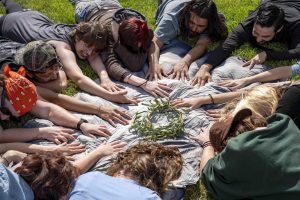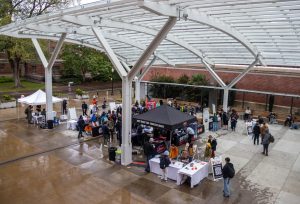Ina Haws serves as a reminder: ‘Indigenous people are still here’
A totem pole decoration inside of the Ina Haws Center.
November 3, 2022
In 1973, the Native American Student Association, the Chicano Student Union and the Black Student Union advocated for a shared Cultural Center.
Later that year, the Ina Haws—then called the Native American Longhouse—was created, becoming the first stand-alone center to branch out of the shared Cultural Center and the first center at Oregon State University to represent the Indigenous people of the Americas and Pacific Islands.
This marked the start of years of student activism for more Cultural Centers to provide spaces on campus for students of different identities to call home.
Located in a repurposed World War II Quonset Hut — a lightweight structure made of corrugated galvanized steel in the form of a semi-cylindrical cross-section — the NAL served students from fall 1973 to fall 2013.
The Eena Haws — translating to “Beaver House” in chinook wawa/jargon — opened in winter 2013, in a newly constructed building that echoed the “shape and style of a traditional Oregon Coast longhouse,” according to an OSU press release from May 2013.
“The new center was a response to decades of student and staff advocacy to build a new center and university capital campaign fundraising,” the Ina Haws website stated.
This longhouse is the same one that serves students today.
The center offers all students, faculty, staff and OSU community members a fully-equipped kitchen, computers, TV and video games, lounge, study space, spiritual room, library of books on Indigenous topics and gender-inclusive bathrooms.
The Ina Haws has been decorated with donated artwork from Pacific Northwest Native artists, including the centerpiece, which is a 360-degree totem crafted by two assistant carvers and master carver Clarence Mills, a member of Haida Nation, an Indigenous people located in Canada and Alaska.
“This structure is a combination of several different models in the Pacific Northwest but it’s not intended to be a traditional one, obviously, because it’s a blend of several,” said Luhui Whitebear, center director of the Ina Haws and assistant professor of the School of Language, Culture and Society.
In September 2021, the center announced a name change. According to their website, Kaku-Ixt Mana Ina Haws means “unified strength of the Beaver House” in a combination of chinuk wawa/jargon and Polynesian languages.
“Formally known as the Native American Longhouse Eena Haws, this new name centers Indigenous languages and unity,” the Ina Haws announced.
The name is pronounced Kah-goo EE-hxt (where the x makes more of an h sound), Mah-nuh, EE-nuh, house.
“Just having the space itself is a reminder of whose lands we’re on, and not all of us here that identify as Indigenous are from local tribes, so we also hope that beyond other Indigenous folk on campus, the broader campus will help learn the histories and help educate each other about whose lands we’re on,” Whitebear said. “This space serves as a reminder of that; that Indigenous people are still here.”
“The Ina Haws prides itself in being a brave space that Indigenous students can be in community and express their culture,” the Ina Haws website states. “Events are held fall, winter and spring terms that highlight Indigenous history, culture, and current issues that also help give the broader campus community more understanding about Indigenous people. We always recognize and give thanks to the Kalapuya people whose land OSU resides.”






